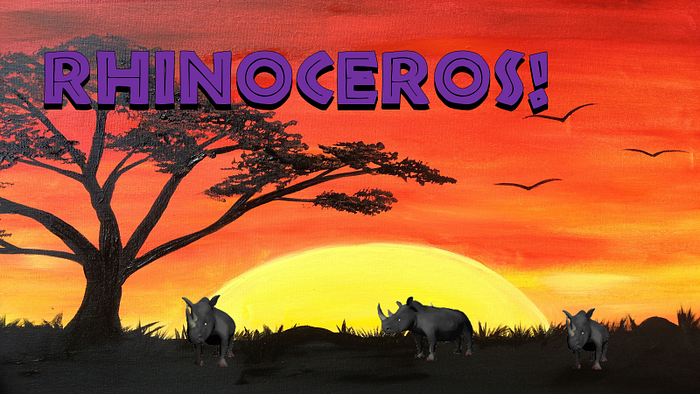Rhinos — And why you should care
Rhinos — and why you should care
~by Angela V. Woodhull, Ph.D.
Ancient Giants of the Savanna:
Rhinos have a captivating history that dates back millions of years. Fossil evidence reveals that these majestic creatures have existed for over 40 million years, making them one of the oldest surviving mammal lineages on Earth. Throughout their evolution, rhinos have undergone remarkable transformations, with some species growing to immense sizes. One such giant was Paraceratherium, also known as the Indricotherium, which stood about 18 feet tall at the shoulder and weighed an astonishing 20 tons. These ancient giants roamed the savannas, leaving behind a legacy of awe-inspiring proportions.
The Power of the Horn:
Perhaps the most iconic feature of rhinos is their impressive horn. The horn is not a true bone but rather a dense accumulation of keratin, the same substance that makes up human hair and nails. However, the rhino’s horn is far from ordinary. It possesses a unique structure that grants it incredible strength and sharpness. Rhinos use their horns for various purposes, including defense, digging for water, and marking territories. Some rhino species, such as the white rhino, have two horns, while others, like the Indian rhino, possess a single prominent horn.
A Tale of Five:
Rhinos are divided into five distinct species, each with its own intriguing characteristics. The white rhino, despite its name, is actually gray in color and is the largest rhino species. Its name is believed to be derived from the Afrikaans word “weit,” meaning “wide” and referring to its wide mouth. The black rhino, on the other hand, has a pointed upper lip, allowing it to browse on trees and shrubs. The Indian rhino has a thick, armor-like skin that is adorned with wart-like bumps. The Javan rhino is one of the rarest large mammals on Earth, with a population of fewer than 80 individuals, making it critically endangered. Lastly, the Sumatran rhino is the smallest rhino species and also critically endangered, with less than 80 individuals remaining.
The Nose Knows:
Rhinos possess a remarkable sense of smell, which plays a vital role in their daily lives. Their olfactory abilities are so acute that they can detect the presence of other rhinos, even from considerable distances. This keen sense of smell allows them to communicate and establish social hierarchies. Additionally, rhinos use their sense of smell to identify food sources, locate water, and detect potential predators. The remarkable olfactory prowess of rhinos highlights their dependence on their environment and the crucial role it plays in their survival.
A Mighty Crash:
Rhinos are known for their solitary nature, but they also exhibit fascinating social behavior. While they may spend much of their time alone, they form temporary associations known as “crashes” when conditions are favorable. A crash can consist of several rhinos, often of different ages and genders, coming together to socialize and graze peacefully. These gatherings allow rhinos to interact, communicate, and potentially find mates. The social dynamics within a crash are complex and can vary between species. Witnessing a gathering of these magnificent creatures is a sight that speaks to the intricacies of their social lives.
The Elusive Rhino Language:
Communication among rhinos is a captivating aspect of their behavior. While they may not possess a spoken language like humans, they rely on a range of vocalizations, body signals, and scent marking to convey messages. Rhinos produce a variety of sounds, including grunts, roars, bellows, and even honks. These vocalizations serve different purposes, such as expressing aggression, establishing dominance, or communicating with their young. Rhinos also use body language, such as head movements, ear positions, and tail postures, to convey their intentions and emotions. The intricate language of rhinos is a testament to their ability to communicate and connect with one another.
Guardians of Ecosystems:
Rhinos play a vital role in their ecosystems, acting as keystone species and ecosystem engineers. As herbivores, they shape the landscape by grazing on vegetation, creating open spaces that benefit various plant and animal species. Rhinos also disperse seeds through their dung, aiding in the regeneration of plant communities. These giants are known to modify their surroundings, such as wallowing in mud to cool down and protect their skin from parasites. These wallows then become watering holes for other animals during dry periods. By conserving rhino populations, we not only preserve a magnificent species but also safeguard the health and balance of their habitats.
Rhinos are extraordinary creatures that captivate our imagination with their ancient origins, their formidable horns, and their fascinating social behavior. Their acute sense of smell, unique communication methods, and ecological significance further contribute to their allure. Understanding and appreciating these intriguing aspects of rhinos can deepen our connection with these magnificent animals and inspire us to protect them for future generations.
Here’s a song I wrote for kids, to get them thinking about rhinos, and learn a few facts. You’ll also learn some Swahili phrases that repeat the English lyrics. Enjoy! https://www.youtube.com/watch?v=f9akSDuYyxI
